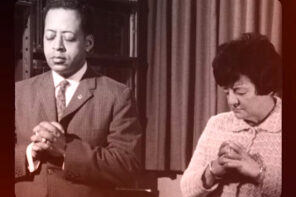I remember it still. I was, I don’t know—eight, nine?—and found myself nervously looking up the definitions of “maximum” and “minimum” in our big green-and-gold World Book dictionary (reading comic books was like this—you were always looking up things). It was all terribly important, since I was considering sending $4.99 to an address at the back of a comic that promised me, yes me, “maximum” muscle growth in a “minimum” amount of time. I really had no idea what those two words meant, so I was quite pleased when I learned that the first word means “most” and the second word “least.”
Wow! The best of both worlds. Or both words.
So off went the $4.99 (plus $1.50 shipping and handling) and back came this weird little booklet that looked like it had been mimeographed. In a garage. Poorly. Every single sentence ended with an exclamation point (for some reason, I was okay with that). My brother Jerry and I spent a summer month following its grueling instructions on how to add a whole inch to our biceps, which basically involved curling dumbbells every other hour all day long until we turned blue and couldn’t lift our arms any longer.
It was awesome.
And that was just the beginning of the wonders. There were the decoders and spy cameras (ordered one), the martial arts secrets advertised in martial arts comics (yep, ordered ’em—don’t mess with me), even underwater sea monkeys (nope—drew the metaphysical line about right there). Okay, the latter ads were peddling freeze-dried brine shrimp, but we didn’t know that. And on and on it went, breathlessly, at the back of a single 20-cent comic.
Anything was possible. We felt immortal, like minor gods in the making, and those superhero comics were our instruction books on how to imagine our own inner superhood into being. We knew, of course, that the stories were “not real,” but that’s not how our imaginations related to their bright plots, or to the ripped male bodies and busty, leggy female forms arching across the interior pages (there’s another story—don’t get me started). No one, after all, had yet told us that our crystalline sense of awareness was just a froth of neurons firing; that we were just biological robots locked into our local language and cultural games; that life is really about money, power, and politics. We didn’t know any of this. Not that it would have made any sense.
It still doesn’t.
Super-Constructions and Paranormal People
I dug my comics out of the closet in my early 40s and took them to a local Houston comic book store. At least, I reasoned, I could get a few bucks from these silly childhood fantasies. That was not what happened. The imagination happened. The eventual result, some eight years later, was two books: one on psychical phenomena in the study of religion (Authors of the Impossible); and one on the paranormal and popular culture (Mutants and Mystics).
I learned cool stuff in the process. I learned, for example, that the categories of the psychical and the paranormal possess elite intellectual roots. They were invented by British, American, and French academics and scientists in the 19th and early 20th centuries to help explain things like mothers having knowing dreams of sons dying hundreds of miles away and poltergeist phenomena exploding around emotionally troubled, sexually conflicted pubescent boys and girls (the sorts of boys and girls who would have been reading superhero comics, had they had them).
The word “paranormal” was coined around the turn of the 20th century by French scientists studying these “angry ghosts.” The new word had probably morphed from an earlier one used by a Cambridge classicist named Frederic Myers: “supernormal.” The word did double work for Myers: it offered an alternative to “supernatural,” and it carried distinct evolutionary connotations. Like a wormy caterpillar witnessing the graceful wings and bright colors of a floating butterfly nearby, Myers thought that human capacities like telepathic communications and precognitive dreams were early signs of an evolving supernature—ours.
Both the supernormal and the paranormal were later picked up by an American writer of glorious talent and wicked humor named Charles Fort. Charles sat in the New York Public Library every day for decades, reading pretty much every periodical in French and English back to 1800 as he looked for reports of “super-constructions in the sky” (what we would now call UFOs) and paranormal people. He found plenty of both.
In works like The Book of the Damned (1919) and Wild Talents (1932), Fort created an entire super-vocabulary. Here we encounter things like a super-bat, super-biology, super-chemistry, a super-dragon, super-evil, super-geography, super-imagination, super-magnets, super-mind, super-religion, super-scientific attempts, super-sociology, super-sight, super-vehicles, super-voyagers, super-whiskeys (with ultra-bibles, no less), and super-wolves. Through such words, Fort sought to communicate an emerging new worldview that was defined by what we would today recognize as the paranormal and the extraterrestrial. In other words, he meant what superhero comics mean by the prefix. Except that he was claiming this was the stuff of our daily lives. He was claiming that the fiction is real; or better, that the real is itself a kind of fiction. We are written. By what or whom, it is not at all clear.
In short, the “super” of the comics was not invented in 1938 with the creation of Superman, nor can it all be explained by some kind of vague adaptation of Nietzsche’s famous quasi-Darwinian line about how man is a transitional figure between the ape and the Superman. There were other origin stories.
A Placental Support System Called Earth
Including experiential ones. Authors and artists, it turns out, routinely undergo profound, life-changing mystical experiences and then encode these events in their fantasy and fiction. Consider the work of Grant Morrison, a Scottish punk rocker and bad boy turned mega-popular comic writer whose mind-bending writing has influenced such blockbuster films as The Matrix and X2: X-Men United. Morrison’s work is suffused with fierce countercultural sensibilities and a dramatic contact experience he underwent in Kathmandu, Nepal, in 1994. Morrison had played with the paranormal notion of “being written” since his early work in books like Animal Man, but the Kathmandu event clearly turbo-boosted this idea into orbit, as is evident in his metaphysical manifesto, The Invisibles. Fans, eager for another major statement, now have it in the recently released Supergods.
The book is at once a rich, humorous history of comics, a political commentary on the absurdities of conservative British and American culture, and a deeply personal memoir. The relevant moments for us here involve those in a Kathmandu hotel room just after the writer had visited a Tantric Buddhist temple. As Morrison chills on the roof of the Vajra Hotel, he sees the temple come alive and begin to rear up like one of those living sports cars in the Transformers movies.
He retreats to his room, only to find chrome-like presences emerging from the walls and furniture. Their liquid mercurial forms challenge even the writer’s way with words: they were “rippling, dribbling blobs of pure holographic meta-material angels or extraterrestrials.” Whatever they were, they communicated with Morrison, transported him to what looked like a distant planet, and then showed him the secret of the universe, which involved a kind of hyperdimensionality. In the simplest terms, he was “turned around.” More complexly, “my being was rotated through a plane I could not now point to” into an azure hyperfield laced with shimmering, lattice-like information grids. Morrison had been “twisted off the surface of the universe into the fifth dimension,” into eternity, into infinity.
The revelations followed fast and furious. One involved his realization that all of life on this floating planet is a “single weird anemone-like mega-Hydra with its single-celled immortal root in the Precambrian tides and its billions of sensory branches, from ferns to people,” stretching into the present and future. It was as if he had been shown “an infant god, attached to a placental support system called Earth.”
Like many visionaries before him, Morrison understood that he had to return from these heights—in his case to help “midwife” the infant earth-god. And so he came back, back into the meat-body. But back with a superpower. For a time at least, he could sense things, from a coffee cup to a coffee barista, in five dimensions: “I could see the shapes of things and of people as the flat plane surfaces of far more complex and elaborate processes occurring in a higher dimensional location.”
A human being now looked like a billion-limbed Hindu deity extending through time as it wormed back from the present moment and evolved forward into the future: “Everything was immortal and holy not as a result of some hidden supernatural essence but as a consequence of its material nature in time.” This is no standard materialism, though. This is a bright “Transcendental Materialism.” Consciousness, Morrison speculates, is the sought-after unified field that ties everything together, that gives the universe its shape, direction, and life. Or, as he puts it in the stunned mystical realization of Lex Luthor in All-Star Superman, the fundamental forces of physics are “all yoked by thought alone.”
Like Luthor’s tear-filled realization of a cosmic Super-Mind, Morrison’s contact experience in Kathmandu “completely rewrote” him. And now he would write it. He, after all, could now relate to his fictional characters on the two-dimensional page much as the fifth-dimensional creatures had related to him in our three. These mercurial intelligences could get into our skulls, he points out, “as easily as we can read Batman’s private inner monologues on a 2-D page.”
They could also move backward and forward in time, much as we can time-travel through a narrative by flipping the pages of the comic back and forth. He even recognized that things like telepathy and reincarnation would not be much of a mystery within this ecomystical vision, as they would be easily possible if everything everywhere were one giant meta-organism stretched across eons. For what in such a super-reality is not already in communication, already connected, already one body, already always one?
Like the other creative talents I treat in my recent work (Doug Moench, Ray Palmer, Jack Kirby, Barry Windsor-Smith, Philip K. Dick, and Whitley Strieber), Grant Morrison is drawn to cutting-edge science as the best source for metaphors to articulate what he knew. Modern science is what gives shape to his modern mysticism. And so he writes about hyperdimensions, the brane and bulk of contemporary cosmology, and, of course, evolution. These scientific models are never sufficient, however. And so the creators turn to mystical literature as well. Indeed, over and over, they actually call themselves Gnostics, by which they mean to invoke both their radical rejection of institutional religion as so many power-games and the fantastic ways they have encountered Mind beyond the space-time grid.
Gnostics indeed. They just happen to be expressing their revelations through comics and sci-fi novels instead of scriptural commentary and spiritual treatises: theirs is a secret hidden in plain sight. Through their popular works of fantasy and the highly technical parapsychological literatures that preceded them, the supernatural has morphed into the supernormal, and finally into the superhero. The paranormal has become popular culture. This may not be an entirely satisfying ending, but it is a most hopeful beginning. It is, after all, very good to be super again.
I still recommend passing on the sea monkeys, though.




